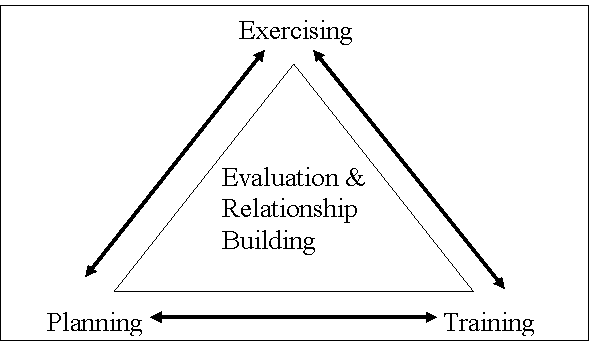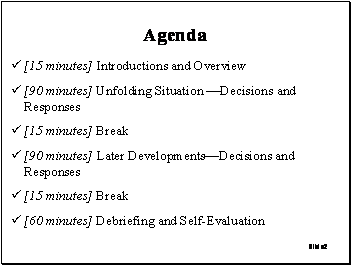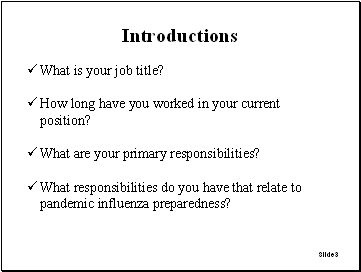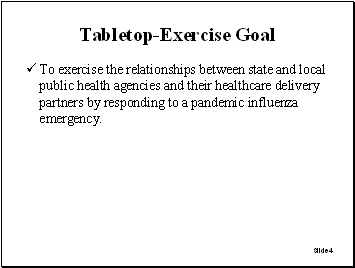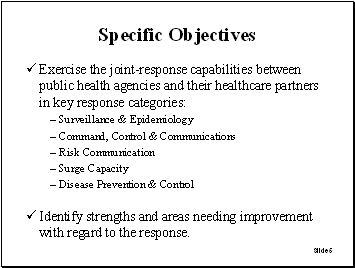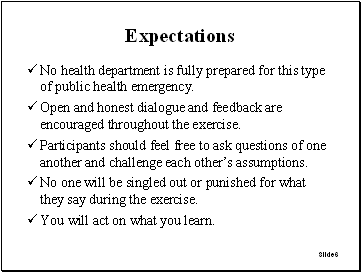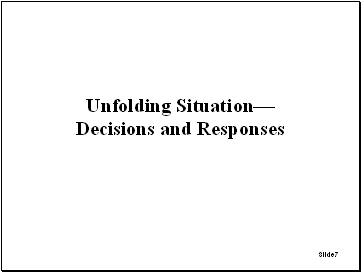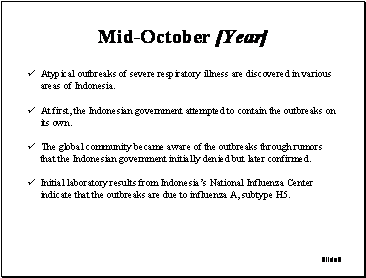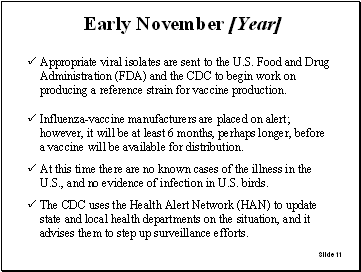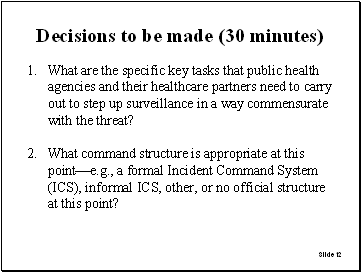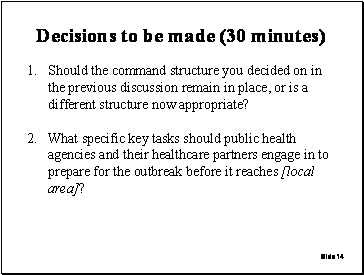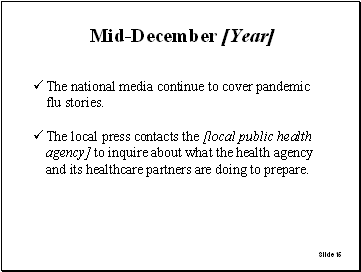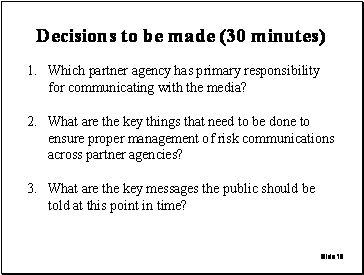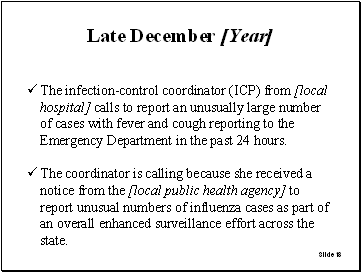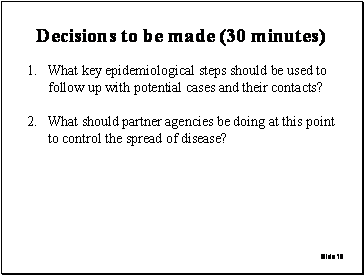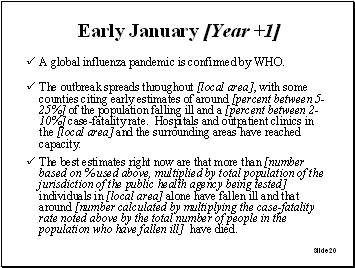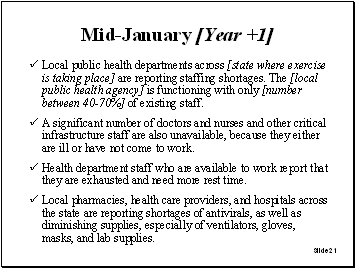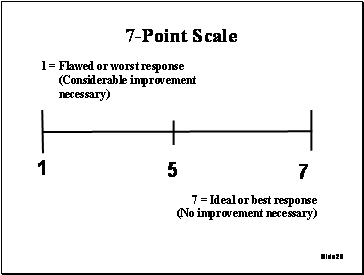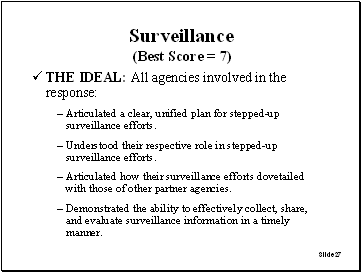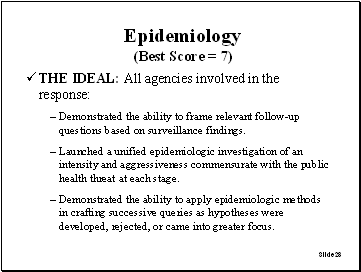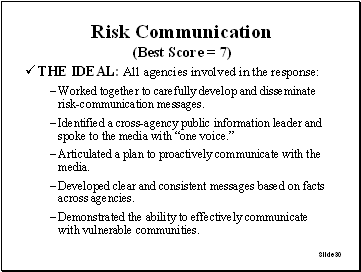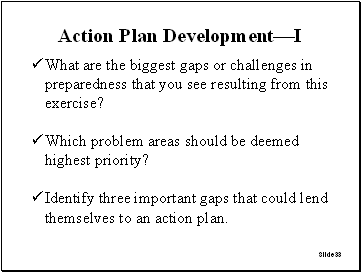TABLETOP EXERCISES FOR PANDEMIC INFLUENZA PREPAREDNESS IN LOCAL PUBLIC
“FLU AT THE ZOO” TABLETOP EXERCISE (TTX) 2012 JUNEBUSINESS CONTINUITY TABLETOP EXERCISE TEMPLATE BASIC SCENARIO THURSDAY NORMAL
SITUATION MANUAL VIRTUAL TABLETOP EXERCISE (SITMAN) WINTER STORM VIRTUAL
TABLETOP EXERCISE BOMB THREAT USE THESE QUESTIONS TO
TABLETOP EXERCISE EARTHQUAKE USE THESE QUESTIONS TO GUIDE
TABLETOP EXERCISES FOR PANDEMIC INFLUENZA PREPAREDNESS IN LOCAL PUBLIC
Tabletop Exercises for Pandemic Influenza Preparedness in Local Public Health Agencies
|
Tabletop Exercises for Pandemic Influenza Preparedness in Local Public Health Agencies David Dausey, Julia Aledort, Nicole Lurie TR-319-DHHS December 2005 Prepared for the U.S. Department of Health and Human Services Office of the Assistant Secretary for Public Health Emergency Preparedness. Report prepared December 2005, released December 2006. Contents
Preface This report presents a fully customizable template for a tabletop exercise for pandemic influenza preparedness that can be used by state and local health agencies and their healthcare and governmental partners as an exercise in training, in building relationships, and in evaluation. We refined these exercises by pilot-testing them at three metropolitan-area local public health agencies in three separate states from August through November 2005. The contents of this report will be of interest to public health professionals at the state and local levels who are involved in pandemic preparedness activities in their agencies. This work was prepared for the U.S. Department of Health and Human Services, for which Dr. William Raub, Principal Deputy Assistant Secretary for Public Health Emergency Preparedness, served as project officer. The research was conducted in the RAND Health Center for Domestic and International Health Security. A profile of the Center, abstracts of its publications, and ordering information can be found at http://www.rand.org/health/centers/healthsecurity/. RAND Health is a division of the RAND Corporation. More information about RAND is available on our Web site at http://www.rand.org. A global pandemic influenza outbreak represents one of the most catastrophic threats to the U.S. public health system. In the 20th century, three major pandemics were caused by the emergence of several new influenza A virus subtypes that resulted in over 600,000 deaths in the United States (U.S. Centers for Disease Control and Prevention [CDC], 2005). New influenza A virus subtypes, similar to the ones that caused the pandemics of the 20th century, are likely to emerge in the 21st century as well. Medical advances and public health preparedness efforts have improved the nation’s abilities to respond to a pandemic influenza emergency even as dramatic increases in global travel and the demand for poultry have made the United States more vulnerable to such threats. In preparing for such a threat, public health agencies must work closely with a number of partners, including emergency management agencies, law enforcement agencies, elected officials, and, most important, healthcare agencies and providers. Despite the importance of these relationships, many public health agencies have been unable to find ways to facilitate their growth and development, which has led to a number of important gaps in the ability of these partners to respond to a pandemic influenza emergency in a coordinated way. In 2004, the U.S. Department of Health and Human Services Office of the Assistant Secretary for Public Health Emergency Preparedness contracted with the RAND Corporation to develop and pilot-test a tabletop exercise that tested the relationships between local public health agencies and their local healthcare delivery and governmental partners in response to a pandemic flu emergency. This report represents the final exercise we developed from that project. The tabletop exercise template provided in this report was designed to be customized by local partner agencies so that it would be representative of the local area being tested and to be flexible in the size, scale, and scope of the pandemic itself. The exercise was piloted and refined in collaboration with hundreds of public health, healthcare, and governmental officials in three separate local metropolitan areas in three different states from August to November 2005. The exercise template builds on tabletop-exercise methodologies developed and refined by RAND in previous work (Dausey et al., 2005). The exercise is led by a facilitator who presents participants with chronological segments of a scenario separated by a series of discussion points that enable participants to describe how they would respond to the evolving scenario at isolated points in time. The exercise facilitator is aided by a note taker and a local resource person who is responsible for assisting or backing up the facilitator. The exercise relies on a “forced decision-making” framework, which requires participants to make key decisions at each discussion point after they have had time to consider the scenario and the information provided to them at a specified point in time. Participants are given 30 minutes to make one or two key decisions at each discussion point. The exercise focuses on five broad issue areas: Surveillance and Epidemiology Command, Control, and Communications Risk Communication Surge Capacity Disease Prevention and Control.
The exercise has three sections: Unfolding Situation--Decisions and Responses. A new influenza A subtype has been spreading from person to person in countries in Southeast Asia and initially materializes in the United States in a location distant from the local jurisdiction of the exercise participants (e.g., in another, nonadjacent U.S. state). Participants are required to discuss the steps they would take to prepare for the disease before it spreads to their jurisdiction. Later Developments--Decisions and Responses.The disease spreads to the local jurisdiction of the participants. Participants are required to discuss everything from how they would initially detect the disease’s presence in their community, to how they would mitigate the disease’s effect on their community, to how they would manage, distribute, and administer a vaccine for the disease. Debriefing and Self-Evaluation. Participants reflect on the exercise experience and discuss strengths and areas for improvement. Participants are then asked to identify the three most important gaps that they identified and to outline concrete, short-term plans for beginning to address these gaps. Participants are encouraged to develop short- and long-term plans for all of the gaps identified.
This report is one part of a larger project being conducted by the RAND Corporation, with funding from the U.S. Department of Health and Human Services, to examine exemplary public health practices, learn from public health experiences, and develop exercises to improve public health preparedness. Many people at RAND helped shape our thinking and approach to this work. We would like to acknowledge and thank the entire RAND team on this project for its efforts. Developing this report involved the participation of hundreds of professionals from public health agencies, healthcare agencies, and local government in three local metropolitan areas in three separate states. We are deeply grateful for their willingness to participate in a pilot exercise and to provide us with constructive feedback on how to improve the exercise. This work benefited especially from an active collaboration between RAND and the Georgia Division of Public Health on a separate but related project, and we are indebted to the leadership of the Division for advancing our thoughts on this topic. We thank James Buehler, Research Professor, Department of Epidemiology, Center for Public Health Preparedness and Research, Rollins School of Public Health, Emory University, and Roger Molander at the RAND Corporation for their in-depth reviews. We also acknowledge the assistance and guidance of William Raub, Principal Deputy Assistant Secretary for Public Health Emergency Preparedness, and Lara Lamprecht, Program Analyst, both of the Office of Public Health Emergency Preparedness at the U.S. Department of Health and Human Services. Their commitment to building and strengthening the nation’s public health infrastructure to respond to pandemic influenza was the primary force shaping this work.
“The
bonding of a team is enhanced when its members exercise together.
This allows everyone to begin to understand how they will work
together under the pressure of ‘the real thing.’” In its recently revised and updated HHS Pandemic Influenza Plan, the U.S. Department of Health and Human Services (HHS) highlighted the need for all stakeholders (federal, state, and local) involved in responding to an influenza pandemic to “develop, refine, and exercise” preparedness plans (HHS, 2005). The plan emphasized the importance of “pre-established partnerships and collaborative planning at the local level by public health officials, hospital administrators, and community leaders who have considered the range of best and worst case scenarios.” It provided guidance to these partners on 11 key areas of pandemic influenza planning and response, displayed in Figure 1.1. Each of these areas can be thought of as one spoke in a wheel comprising pandemic influenza planning and response.
Figure
1.1: Eleven Key Areas of Pandemic Influenza Planning and
Response
SOURCE: U.S. Department of Health and Human Services (2005). The template tabletop exercise provided in this report was created to supplement this guidance. The exercise is designed as a training exercise to build relationships, foster collaborations, and establish pre-pandemic planning between three groups primarily involved in the response to pandemic influenza at the local level: public health agencies, healthcare organizations, and local government. The large size and the scope of the HHS Pandemic Influenza Plan make it impossible to completely cover every single aspect of the 11 key areas outlined in Figure 1.1. Instead, the exercise focuses on five issue areas: Surveillance and Epidemiology Improve reporting and detection of pandemic influenza to increase opportunities for timely investigation and response. Bolster epidemiological capacity to investigate and direct the response to a pandemic threat.
Command, Control, and Communications Manage the public health response (including interactions with other agencies) effectively in the event of a pandemic emergency. Establish and clarify responsibilities and lines of communication among local, state, and federal agencies.
Risk Communication Provide the public with access to accurate information and guidance in the event of a pandemic. Ensure effective communication by local public health to its constituents as part of pandemic prevention and control.
Surge Capacity Effectively expand capacity by hospitals and healthcare providers to meet the needs of the population. Manage coordination of surge issues between local public health and their healthcare delivery partners (e.g., increased calls from the public and escalating demand for critical medical supplies).
Disease Prevention and Control Rapidly immunize large numbers of people in the event of an epidemic involving a vaccine-preventable infection. Obtain and dispense any appropriate post-exposure prophylaxis or other clinical preventive services in the event of a pandemic.
These
issue areas were chosen because they intersect with all of the 11
key areas of the HHS plan (as displayed in Figure 1.2) and because
they represent issues that previous Figure 1.2: Mapping of HHS Key Areas and Tabletop Exercise Issue Areas
Chapter Two Design and Methodology
“Exercises
are conducted to evaluate an organization’s capability to
execute one or more portions of its response plan or contingency
plan. Many successful responses to emergencies over the years
demonstrate that exercising pays huge dividends when an emergency
occurs.” The exercise contained within this report is designed to test the relationships between local public health agencies, healthcare agencies, and governmental officials in response to a pandemic influenza emergency. Healthcare delivery partners are defined as all healthcare agencies and organizations that could conceivably be involved in responding to a pandemic influenza emergency. The objectives of the exercise as outlined in Figure 2.1 are threefold: Exercising—test the joint response capabilities between public health agencies and their healthcare partners in key pandemic influenza response categories and identify strengths as well as areas for improvement (i.e., evaluation). Planning—to assist public health agencies and their healthcare partners in testing and evaluating their pandemic influenza plans. Training—to train responsible officials in appropriate sectors that will be involved in a pandemic influenza response and, in doing so, help strengthen the ties between them (i.e., relationship building).
To achieve the exercise objectives, a variety of local-level participants can be involved. Each site planning an exercise will need to decide which local-level participants to involve in its exercise. Our experience has been that exercises with 15 to 20 participants afford better group dynamics and allow all participants an opportunity to speak. Exercises with larger numbers of participants are more difficult to facilitate and often do not engage all participants. In some instances, it may be difficult to limit the exercise to less than 20 participants. One solution to this dilemma is to specify some individuals as exercise participants and everyone else as an observer. Observers can occasionally interject comments; however, their primary role is to observe the exercise. Below, we highlight potential participants for exercise. Which participants are appropriate to involve in an exercise depends on the characteristics of the local area being tested and the size and structure of the agencies and organizations that might respond to a public health emergency (such as an influenza pandemic) in a particular local community.
Figure
2.1: Pandemic Influenza Tabletop Exercise Objectives
SOURCE: Adapted from Showronski (2003). Suggested local public health participants include the following: Local medical director Public health preparedness coordinator Public information officer Influenza planning coordinator Immunization representative Epidemiologist Emergency management representative State health department liaison.
Suggested local healthcare participants include the following: Infection-control practitioner from one local hospital Hospital administrator from one local hospital Emergency department doctor from one local hospital Local private practice doctor(s) EMS representative.
Suggested local governmental-official participants include the following: Law enforcement representative Local government official (e.g., mayor, city council member).
The exercise consists of three broad sections: Unfolding Situation--Decisions and Responses. A new influenza A subtype has been spreading from person to person in countries in Southeast Asia and initially materializes in the United States in a location distant from the local jurisdiction of the exercise participants (e.g., in another nonadjacent U.S. state). Participants are required to discuss the steps they would take to prepare for the disease before it spreads to their jurisdiction. During this part of the exercise, participants are required to make key decisions about disease surveillance and epidemiology, surge capacity, and command, control, and communications.
Later Developments--Decisions and Responses.The disease spreads to the local jurisdiction of the participants. Participants are required to discuss everything from how they would initially detect the disease’s presence in their community, to how they would mitigate the disease’s effect on their community, to how they would manage, distribute, and administer a vaccine for the disease. During this part of the exercise, participants continue to make decisions about command, control, and communications and also make decisions regarding risk communication and disease prevention and control.
Debriefing and Self-Evaluation. Participants reflect on the exercise experience and discuss strengths and areas for improvement. Participants are then asked to identify the three most important gaps that they identified and to outline concrete short-term plans for beginning to address these gaps. Participants are encouraged to develop short- and long-term plans for all of the gaps identified.
Three people are needed to conduct the exercise: Facilitator Resource person Note taker.
The role of the facilitator is to introduce and periodically update the exercise scenario. The facilitator also moderates the discussion by asking participants questions or probes, and by encouraging participants to make concrete decisions on key issues.1 To aid the facilitator, the exercise contains a series of template facilitator probes in the notes page of each slide titled “Decisions to be made.” Ideally, the facilitator should not be directly associated with any of the agencies participating in the exercise, especially if there is a major evaluation component to the exercise. The facilitator could be a retired pubic health or healthcare agency official; an official from the state or another nearby jurisdiction; or a knowledgeable professional facilitator. Alternatively, for some educational and early training purposes, a local official as facilitator might well be appropriate to meet exercise objectives. The resource person is responsible for assisting or backing up the facilitator. For example, if the participants get off course, make a technical mistake, or fail to sufficiently consider relevant alternatives, the resource person would be responsible for determining whether it would be appropriate to inject corrective advice and, if so, offering that guidance. Doing so relieves the facilitator of constantly having to juggle attention to the process and content of the discussions, which can be challenging. Moreover, the objectives of relationship building, training, and evaluation may at times be at odds with one another, and this possibility should be anticipated in considering when it would be appropriate for a resource person to intervene (or in considering how directive the facilitator should be). Ideally, the resource person would be familiar with the state and locality’s pandemic influenza planning efforts and would be involved in planning the exercise to ensure local relevance. For example, it could be a representative from a neighboring health department. The note taker is in charge of recording the high points of the discussion and of highlighting topics for potential discussion during the debriefing and self-evaluation. The note taker is also in charge of writing on the whiteboard or chalkboard during the debriefing and self-evaluation as participants highlight the initial steps of an action plan. After an exercise has been completed, the note taker and facilitator should collaborate to create an after action report (AAR), which presents an overview of the exercise experience and highlights the strengths and areas for improvement identified at the end of the exercise. There is no specific format for an AAR; however, AARs usually contain a few broad categories: General information—details about the date, time, and location of the exercise. Objectives—a brief overview of what the exercise was intended to cover or achieve. List of participants—a list of the individuals who participated in the exercise. In some instances, this list includes job titles rather than names, for confidentiality. Major categories of response tested—a summary of the issue areas that were covered in the exercise. Executive summary of exercise performance—an overview of the strengths and weaknesses observed in the exercise. Brief review of exercise experience—a detailed account of the exercise experience, which summarizes the key debates participants had during each discussion point and the decisions they made. Summary of initial action plan—a list of the areas for improvement summarized by the participants at the end of the exercise and a brief description of their action plan to begin addressing the three most prominent areas for improvement.
The AAR should be no longer than 15 or 20 pages. Chapter Three Tabletop Exercise General Description This chapter contains the template for the exercise. This template is available for downloading as a customizable Microsoft PowerPoint presentation at RAND’s Web site (www.rand.org/health/surveys_tools/panflu_ttx/index.html). Copies of the slides, as well as the facilitator instructions and probes, are found in this chapter. The facilitator instructions and probes presented below are available in the customizable PowerPoint presentation in the notes pages of the slides. The template is designed to be customized in three areas: Locations and organizations included in the exercise Size and scope of the epidemic Timing of the epidemic
The parts of the exercise to be customized are in bracketed italicized text on the slides, such as: [example]. The template comprises three primary components: Sample presentation slides with situation reports Facilitator instructions Discussion points with facilitator probes
The exercise begins with an initial situation report, which puts the exercise into context. The situation report supplies a back-story, providing a brief account of the key events leading up to the pandemic. The initial situation report is updated throughout the presentation. Situation updates are used throughout the exercises to update the scenario presented in the initial situation report. Situation updates keep the discussion moving forward and encourage flexibility in responding to different stages of an emergency. Situation reports can be customized to be more relevant to the local environment. The presentation slides are intended to be shown in chronological order, with breaks in between the slides for discussion points. At these points, the facilitator can use probes to stimulate discussion and to keep the discussion focused. Slide 1
The following PowerPoint slides can be downloaded and customized from RAND’s Web site at www.rand.org/health/surveys_tools/panflu_ttx/index.html. Slide 2
Facilitator
instructions: Slide 3
Facilitator
instructions: Slide 4
Facilitator
instructions: Slide 5
Facilitator
instructions: Slide 6
Facilitator
instructions: Slide 7
Facilitator
instructions: Slide 8
Facilitator
instructions: Slide 9
Facilitator
instructions: Slide 10
Facilitator
instructions: Slide 11
Facilitator
instructions: Slide 12
Facilitator
Probes: What actions should be taken to engage partners in stepped-up surveillance efforts? How will any prior planning for surveillance be utilized in this situation? What guidance should be provided to healthcare partners regarding their surveillance efforts? How will the local public health agency coordinate surveillance and reporting with partners?
Probes for healthcare partners: What responsibilities related to surveillance do hospitals and front-line physicians have? What expectations do healthcare providers have for public health agencies? What type of surveillance should be established in emergency rooms? What is the role of hospitals and laboratories during stepped-up surveillance efforts?
Probes for all partners: How would stepped-up surveillance be different from normal influenza-surveillance activities? How is information on cases systematically collected and aggregated? Who will communicate what information to labs? Should anything be done to ensure that existing response systems are working correctly?
Decision
2: Who is responsible for activating ICS protocols? Who is in charge of the ICS? What partner agencies will be involved in the ICS? How will the ICS be used to manage the response across partner agencies?
Probes for if a formal ICS is not activated: Is there a defined trigger for when it is appropriate to establish a formal ICS? How will all healthcare partners be involved in coordinated decisionmaking pre-ICS? What communication channels will be used across partner agencies?
Probes for either decision: What partner agency is in charge of coordinating and leading stepped-up surveillance efforts? What partner agency is responsible for reviewing global, national, regional, and local influenza-activity trends to identify emerging problems?
Slide 13
Facilitator
instructions: Slide 14
Decision
1: What specific changes are appropriate? What is different now that requires the change? What partner agency is in charge of the new structure?
If the command structure will not change: Why is no change necessary? By what means and how often should partners communicate with one another?
Probes for either decision: What guidance or directives should the public health agency give to healthcare agencies? How will the public health agency work with healthcare agencies to manage the “worried well”?
Decision
2: How should agencies coordinate surge-capacity planning? What should be done to coordinate the supply of scarce medical supplies? What should be done to plan for future surge-capacity needs related to critical infrastructure? What can be done to anticipate and limit the number of “worried well”? Are partners considering plans to establish nontraditional healthcare facilities? What should be done to plan for surge-capacity needs related to staffing at partner agencies? Is it appropriate to think about recruiting and training volunteers at this time? Are there healthcare professionals who could be identified to help in an emergency? Are there legal issues (licensing and liability issues, ethical issues, issues related to isolation and quarantine) that need to be addressed before the disease reaches the local area? How will HHS guidelines for priority groups to receive antiviral drugs be translated into practice?
Probes related to disease prevention: What activities should partner agencies engage in related to disease prevention? What nonpharmacological approaches to disease prevention are appropriate at this time? What should be done to deal with the limited supply of antiviral medications? Is it appropriate to begin pre-identifying priority groups for antiviral prophylaxis?
Slide 15
Facilitator
instructions: Slide 16
Facilitator
probes: What person(s) within the public health agency will be responsible for directly communicating with the media? How will the public health agency involve other partner agencies in risk-communication planning?
If an agency other than public health is chosen: Why is public health not the agency responsible for communicating with the media? What person(s) will be responsible for communicating directly with the media? How will risk-communication messages be coordinated across partner agencies?
Decision
2: Should partner agencies wait for the press to contact them, or should they be proactive and schedule regular press conferences? What channels should be used to get consistent messages out to the public? Are there special strategies that need to be considered to communicate with minority groups or special-needs populations? How often should partner agencies communicate with the media and in what manner?
Decision
3: What do you anticipate are the questions partner agencies will most likely need to answer? How can risk-communication messages be designed to minimize public anxiety and fear? What guidance should risk-communication messages contain to try to limit large numbers of worried well from overwhelming the system?
Slide 17
Facilitator
instructions: Slide 18
Facilitator
instructions: Slide 19
Facilitator
probes: What other information would the public health agency like to know from the ICP? For example: Where are the patients now? What tests have been done? Should the public health agency give any advice to the ICP and the hospital? For example, should public health offer advice about the use of personal protective equipment? What other infection-control strategies might be necessary at this point? How would public health staff confirm whether patients were sick with the pandemic flu strain? What is the appropriate level of follow-up for each potential case (e.g., chart review, telephone interview, interview in person, contact tracing)? What samples need to be collected, and who should collect those samples?
Probes for all partners: How is the clinical information handled and managed? How is it collected, aggregated, and shared across partner agencies? What laboratory or laboratories are appropriate to use? How are clinical samples packaged and sent to laboratories?
Decision
2: Should any social-distance protocols be implemented at this time? How will these protocols be enforced and by whom? Should potential cases and their contacts be quarantined? What legal authority does the public health agency have to take such steps as closing schools and involuntarily quarantining individuals?
Probes for all partners: Is antiviral prophylaxis for contacts of patients appropriate at this point? How should decisions be made about allocating the scarce supply of antiviral medications? Who should administer antiviral medications? What nonpharmacological disease-control strategies should be implemented? What is the best way to manage scarce medical supplies and staff?
Slide 20
Facilitator
instructions: Slide 21
Facilitator
instructions: Slide 22
Facilitator
probes: How do partners determine how many staff are available without double-counting? What staff plans are in place to rotate critical staff to avoid complete exhaustion? How will unmet hospital-staffing needs be addressed?
Decision
2: What public health services must remain in place? How might public health assist hospitals to maintain their essential functions?
Probes for healthcare partners: What hospital services must remain in place during the emergency? Should elective surgeries and other elective procedures be canceled? Who makes these decisions? What other critical healthcare services must remain in place? What decisions need to be made about adopting alternative standards of care--for example, shifts in nurse-to-patient ratios?
Decision
3: Should Strategic National Stockpile (SNS) or other antiviral stockpiling be implemented? How is the public health agency working with healthcare facilities and hospitals?
Probes for healthcare partners: In what ways should hospitals revise their existing triage procedures? Who makes these decisions?
Probes for all partners: How are surge-capacity plans coordinated across all partner agencies? In what way are volunteers utilized, and who is in charge of managing volunteers? How and where will nontraditional medical sites be established, managed, and staffed to treat patients? How will people isolated at home receive necessary food and medical supplies? What partner agency will manage the increasing numbers of dead bodies?
More
information on alternative standards of care can be found in AHRQ
(2005).
Facilitator
instructions: Slide 24
Facilitator
probes: How will public health work with its partner agencies to manage and distribute the vaccine?
If an agency other than public health is chosen: Why is public health not the agency responsible? How is the vaccine received and then distributed?
Decision
2: How do you decide who gets the vaccine?
People who have not been ill? Healthcare workers only? Families of healthcare workers? EMS? Law enforcement? Others involved in critical infrastructure?
How will the HHS Pandemic Influenza Plan influence your decisionmaking about who receives vaccines?
Decision
3: How would vaccine inventories be monitored? How would such events as adverse medication side effects be monitored? How would individuals who received the first dose be followed up for their second dose? How does the vaccine get administered?
Who is going to give it? Where will it be given? What recordkeeping plans will be put into place?
What plans would be put in place to recall people who need a second dose? How do you protect the supply of vaccine? How would HHS guidance get implemented? For example, what procedures would be used to verify vaccine-eligibility forms?
Slide 25
Facilitator
instructions:
Slide 26
Facilitator
instructions: Slide 27
Facilitator
instructions: Slide 28
Facilitator
instructions: Slide 29
Facilitator
instructions: Slide 30
Facilitator
instructions: Slide 31
Facilitator
instructions: Slide 32
Facilitator
instructions: Slide 33
Facilitator
instructions: Slide 34
Facilitator
instructions: Agency for Healthcare Research and Quality (AHRQ), Altered Standards of Care in Mass Casualty Events, Rockville, Md.: AHRQ, Publication No. 05-0043, April 2005. Available at http://www.ahrq.gov/research/altstand/altstand.pdf (accessed November 1, 2005). Dausey D. J., N. Lurie, A. Diamond, B. Meade, R. Molander, K. Ricci, M. A. Stoto, and J. Wasserman, Bioterrorism Preparedness Training and Assessment Exercises for Local Public Health Agencies, Santa Monica, Calif.: RAND Corporation, TR-261-DHHS, 2005. Available at: http://www.rand.org/publications/TR/TR261/. Lurie, N., J. Wasserman, M. Stoto, S. Myers, P. Namkung, J. Fielding, and R. B. Valdez, “Local Variation in Public Health Preparedness: Lessons from California,” Health Affairs, W4-341-53, 2004. Nudell, Mayer, and Norman Antokol, The Handbook for Effective Emergency and Crisis Management, Lexington Books, Lexington Massachusetts, 1999. Showronski, S., “Tabletop Exercises,” presented at the Public Health Technical Network (PHTN) Annual Distance Learning Summit, 2003. Taylor, J. L., B. J. Roup, D. Blythe, G. K. Reed, T. A. Tate, and K. A. Moore, “Pandemic Influenza Preparedness in Maryland: Improving Readiness Through a Tabletop Exercise,” Biosecurity and Bioterrorism, Vol. 5, No. 1, 2005, pp. 61 -69. U.S. Centers for Disease Control and Prevention (CDC), Pandemic Influenza Tabletop Exercise Package, Atlanta, Ga., November 1, 2005; last revised March 3, 2006. Available at http://www.hhs.gov/nvpo/pandemics/tabletopex.html (accessed April 23, 2006). U.S. Department of Health and Human Service (HHS), HHS Pandemic Influenza Plan, Bethesda, Md., November 2005. Available at http://www.hhs.gov/pandemicflu/plan/ (accessed November 5, 2005). Copyright Information: Rand Corporation The research described in this report was prepared for the U.S. Department of Health and Human Services. This research was produced within RAND Health’s Center for Domestic and International Health Security. RAND Health is a division of the RAND Corporation. The RAND Corporation is a nonprofit research organization providing objective analysis and effective solutions that address the challenges facing the public and private sectors around the world. RAND’s publications do not necessarily reflect the opinions of its research clients and sponsors. R® is a registered trademark. A profile of RAND Health, abstracts of its publications, and ordering information can be found on the RAND Health home page at www.rand.org/health. © Copyright 2006 RAND Corporation All rights reserved. No part of this book may be reproduced in any form by any electronic or mechanical means (including photocopying, recording, or information storage and retrieval) without permission in writing from RAND.
Published
2006 by the RAND Corporation ------------------------------------------------ 1 Advice on how to effectively facilitate an exercise can be found in Dausey et al. (2005). |
Tags: exercises for, assessment exercises, local, influenza, pandemic, exercises, preparedness, tabletop, public
- SĄLYGINIS SAKINYS UŽDAVINIAI 1 VIENAS GARSUS LIETUVOS PRAMOGŲ PASAULIO
- INDIVIDUAL DRAFTED PLAYER REGISTRATION – SUMMER LEAGUE 2009 (NO
- VOCABULARIO BÁSICO RELACIONADO CON EL CUERPO HUMANO SE HA
- PRAG STRUČNA EKSKURZIJA 2905 –0306 2013 6 DANA 3
- FICHA SOBRE EL PERFIL DOCENTE E INVESTIGADOR DE CADA
- REUNIÓN DE PUNTOS FOCALES DE LA RED DE FORMACIÓN
- QUICK REFERENCE DIGITAL DIALING INSTRUCTIONS ADSD ABBREVIATED DIAL OR
- 8 SBÍRKA INTERNÍCH AKTŮ ŘÍZENÍ GENERÁLNÍHO ŘEDITELE HZS ČR
- ŽÁDOST O NÁJEM BYTU VE VLASTNICTVÍ MĚSTA TELČE (DLE
- REGLAMENTO DE RÉGIMEN INTERIOR EL PRESENTE “REGLAMENTO DE
- CAPÍTULO III ACTIVIDADES DE LAS RELATORIAS INFORMES DE PAÍS
- TEMA 9 LA ECONOMIA EN EL PERIODO DE ENTREGUERRAS
- FACILITATING PROJECT DOCUMENT FOR 2009 – 2012 WORK PLAN
- ZAŁĄCZNIK NR 10 NUMER SPRAWY NADANY PRZEZ ZAMAWIAJĄCEGO PN
- BIM DOO BICIKLI I MOTOCIKLI ZAGREBDRAŠKOVIĆEVA 47 OIB
- MARÍA E UGARTE MARUGARTERHOTMAILCOM URL HTTPWWWPROZCOMPROFILE626618 WORKING EXPERIENCE
- B OSTON MEDICAL CENTER DEPARTMENT OF FOOD AND NUTRITION
- ÓVODA ÉPÍTÉS ENGEDÉLYEZÉSI TERVE KÉSZÜL PÁKOZD DAMJANICH U 14
- DO NOT WRITE IN INTERNATIONAL SOCIETY FOR HEART RESEARCH
- TATTOOING FACT SHEET FOR OPERATORS THIS FACT SHEET IS
- AL (1) VICECONSEJERO DE ASUNTOS SOCIALES ………… D (2)
- SAMPLE BIOBASED CONTRACT LANGUAGE FOR GROUNDS MAINTENANCE TO ASSIST
- KEEPING AND SHARING INFORMATION FORM DURING YOUR PLACEMENT
- ASESINADOS EN ALCAZARÉN 2 DE AGOSTO DE 1936 PUENTE
- Alumnos Datos Alumnos Formados Según Colectivo al que
- SILABUS MATA KULIAH NAMA MATA KULIAH AKUNTANSI PAJAK
- MAG MATO GOSTIŠA STRUKTURA NAČIN KADROVANJA IN USPOSOBLJENOST DELAVSKIH
- I CARCINOMI DI INTERVALLO QUALI INDICATORI DI PERFORMANCE DI
- 2005 UNIT TOTAL DEVELOPMENT COST (TDC) LIMITS NUMBER OF
- ACCESS TO YOUR INFORMATION V20 MAY 2018 ACCESS TO
RELACION DE VACANTES DE SECUNDARIA CONVOCATORIA 041108 CUERPO
 ZÁKLADNÁ ŠKOLA S MATERSKOU ŠKOLOU ŠKOLSKÁ 339 032 61
ZÁKLADNÁ ŠKOLA S MATERSKOU ŠKOLOU ŠKOLSKÁ 339 032 61 CURSO DE PREVENCIÓN Y GESTIÓN DE CRISIS VERSIÓN 2021
CURSO DE PREVENCIÓN Y GESTIÓN DE CRISIS VERSIÓN 2021 PAVĀRU KLUBA RĪKOTĀS LATVIJAS REPUBLIKAS PAVĀRU SACENSĪBAS LATVIJAS GADA
PAVĀRU KLUBA RĪKOTĀS LATVIJAS REPUBLIKAS PAVĀRU SACENSĪBAS LATVIJAS GADANOTICE OF APPEAL – FORM 8 PAGE 3
Torre Castelar (rafael de la hoz Gerardo Olivares James
PROCEDURA PRZYJĘCIA DZIECKA DO ODDZIAŁU PRZEDSZKOLNEGO KLAS SZKOŁY
 5 COMO SE ENFOCA EL LENGUAJE Y LA COMUNICACION
5 COMO SE ENFOCA EL LENGUAJE Y LA COMUNICACION ALTERANTIVE SPLICING RNA SPLICING IS A MECHANISM AFTER TRANSCRIPT
ALTERANTIVE SPLICING RNA SPLICING IS A MECHANISM AFTER TRANSCRIPTOBJAŠNJENJA – RSK 12 ONJAŠNJENJA RAČUNOVODSTVENIH STANDARDA KOSOVA IMAJU
ALTERNATE FORMAT REQUEST FOR TEXTBOOKS (PLEASE COMPLETE NONSHADED SECTIONS
 IREGSZEMCSEI SÚLYEMELŐ IREGSZEMCSE ÉS SZABADIDŐS SPORTEGYESÜLET 7095 IFJÚSÁG U14
IREGSZEMCSEI SÚLYEMELŐ IREGSZEMCSE ÉS SZABADIDŐS SPORTEGYESÜLET 7095 IFJÚSÁG U14A) COM EMPLENAR EL MEU CV? NORMES PER INTRODUIR
 PLAN DE EMPLEO 2021 JUSTIFICACIÓN SUBVENCIÓN ANEXO V –
PLAN DE EMPLEO 2021 JUSTIFICACIÓN SUBVENCIÓN ANEXO V – ZEM ES SLIEKŠŅA DAĻU KOPSUMMA 289444 PAZIŅOJUMS PAR IEPIRKUMA
ZEM ES SLIEKŠŅA DAĻU KOPSUMMA 289444 PAZIŅOJUMS PAR IEPIRKUMASOMERSET ARCHITECTS INDEX BRACKETS BUILDINGS NOT IN SOMERSET
ZAHTJEV ZA ISPLATU NATJEČAJ ZA DODJELU POTPORE U OKVIRU
NHG JAN VAN ESPRIJS 2015 DE JAN VAN ESPRIJS
A MAGYARHONI FÖLDTANI TÁRSULAT A MAGYAR FÖLDTANI ÉS GEOFIZIKAI
69 CARLTON HOUSE TERRACE LONDON SW1Y 5AG ROYAL SOCIETY


